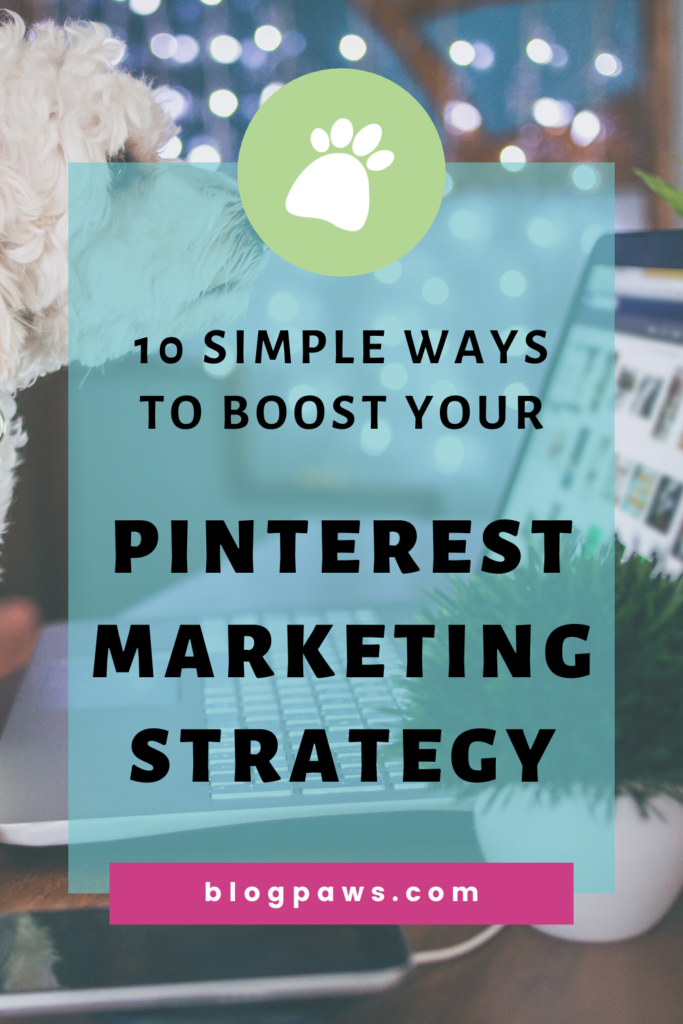10 Simple Ways to Boost Your Pinterest Marketing Strategy
*Updated: January 17, 2023
When Pinterest was in its infancy, the general public thought of it as a social media platform full of froufrou DIY recipes and crafts. Since then, the platform has evolved and changed, and today, this misconception couldn’t be further from the truth. As a result, businesses of all sizes have been optimizing their Pinterest marketing strategy to take advantage of all this platform offers.
Not only is Pinterest a place for any type of business and industry, but it’s used as a search engine rather than a social media website. There are some incredibly simple changes you can make to your Pinterest account to boost your numbers and drive traffic to your blog. You don’t have to be a Pinterest guru to enjoy the benefits of using Pinterest for marketing.
Boost Your Pinterest Marketing Strategy with These 10 Simple Changes
Use SEO Keywords on Each Pin
If you have a blog or website, you’re probably familiar with basic SEO (search engine optimization). Just like on your website, SEO is an important part of Pinterest. To start incorporating SEO, you must identify relevant keywords and include them in your pin’s description.
Many broad keywords like “DIY” or “dog treats” are dominated by large businesses with a Pinterest marketing strategy backed by a significant ad budget. But this doesn’t mean that small business owners can’t still win on the platform. Instead, look for more specific long-tail keywords that your audience may be searching for. For example, instead of “dog treats,” you may have better luck targeting “DIY pumpkin spice dog treats.”
Create Short Pin Descriptions
Your pin descriptions shouldn’t be unnecessarily wordy and redundant. But you do want to take this opportunity to include any of the keywords you identified in the first step. Your description should give a quick snapshot of what your content includes, focusing on why it would be valuable to those who find your pin.
Include a Call-to-Action
If you give away all of your blog post’s information in your pin description, no one will feel the need to visit your blog. Instead, offer just enough information to pique their interest and follow it up with a CTA encouraging them to follow through to your blog to learn more.
If you share a DIY post or recipe, avoid putting the entire process on your pin or your description. If your entire blog post is represented on your pin, readers don’t have any reason to visit your blog.
Design Attractive Board Covers
Simple, attractive board covers will make your account home page look organized, clean and professional. This makes it easier for Pinterest users intrigued by your content to find a relevant board with the information that they desire by allowing them to quickly scan your available boards versus reading the board titles.
Update Board Descriptions
Board descriptions tend to get overlooked when considering an effective Pinterest strategy. Perhaps you have not written descriptions for your boards, or maybe they are outdated. Update them with descriptions that use relevant SEO keywords, much like a pin description. When users are searching for specific topics on Pinterest, this can help to clarify for Pinterest what your content is about, encouraging the platform to include it in the search results.
Create Eye-Catching Pins with Vertical Images
Vertical images are a MUST on Pinterest. More specifically, the ideal pin image has a 2:3 aspect ratio (i.e. 1000 x 1500 px). Your pins need to stand out, and vertical images leverage the layout of the Pinterest feed to give your pin more space. This makes it easier for you to catch the attention of your potential blog readers and draw them in.
Find ways to make your pins stand out. People looking for something specific are drawn to clear photos and bright colors. Try different designs, colors and pictures. Once you discover what your audience is drawn to, you can build your Pinterest content strategy with that information in mind.
Use a Professional Photo of Yourself in Your Account Profile
If a brand is searching for a potential influencer via Pinterest, first impressions mean everything. If you have a dark photo of your pet, it’s a turn-off. Brands like to see who they are working with, even if you are a pet blogger. Use a crisp, bright professional photo of yourself or your business logo. This will also help to build trust with your followers by presenting yourself as a professional.
Redo Your Account Bio
Just like board and pin descriptions, your profile description should use SEO keywords. It should also explain exactly what you’re trying to accomplish with Pinterest. For example, my profile says, “I inspire dog moms to live life to the fullest! I share blogging tips and offer blogging + social media consulting. Subscribe to my blog!”
Design One-of-a-Kind Pins
If your pins are plain and boring, they won’t attract anyone. Try searching the keyword you are targeting and taking note of what other accounts are doing to differentiate yourself. If the vast majority of the pins in the search results are outdoor images in green tones, you may want to choose a relevant image that is a brighter red or orange.
Find Out What People are Searching For
If you have a great pin but aren’t sure what keywords to use, try searching for similar topics and pins. Use the search bar to look up related pins and take note of their descriptions and keywords. You can also do this exercise before creating the pin to help decide what to write specifically on the pin itself. By identifying the terms that are being searched on the platform by your target audience, you can create an organic Pinterest strategy with the potential to drive large numbers to your blog without the budget needed for paid advertising.
How I Got 19k Repins on One Pin in Seven Months
My readers love DIY posts. The dog treat recipes on my blog tend to drive a substantial amount of traffic every day. In spring 2016, I decided to try something new by creating a DIY dog craft that I thought my readers would appreciate – a DIY dog toy box. After spending an afternoon making the box and taking photos of it, I published the blog post and put together an eye-catching pin for Pinterest.
By that time, I had already figured out what style of vertical pin was attracting followers, so I used that template for this particular pin. Keywords I used on my pin included; DIY, Toy Box, Dog Projects, Dog Crafts, Dog Toys, Homemade. My description was short and to the point; “DIY dog toy box – make a super cute box for all of your dog’s toys! Read the whole post to see where I got all of my materials, and find out where you can save money on them!”
The first month was slow for this pin, which I’ve noticed to be the case for most of my pins. Once more people started saving and liking this pin, it increased the chance it would show up in someone else’s news feed.
After that first month, this DIY dog toy box pin began generating about 2,000 repins a month. By the end of 2016, it had a total of about 19,000 repins.
I used a photo template that I knew worked for me and put together a basic keyword description and list of keywords to follow. I literally did nothing else. The pin just sits on Pinterest, month after month, raking in re-pins. And the best part? I make some affiliate money from that post since I added affiliate links to the actual blog post. My other popular DIY pins have anywhere from 1,000-5,000 re-pins.
Pinterest may seem intimidating if you’re unfamiliar, but putting these ten easy steps into play should help you grow a more active account. The possibilities are endless on Pinterest, and I believe it’s entirely underestimated. Start using Pinterest as the search engine as it is, and you’ll be on your way to being a pinning pro!
What questions do you have about Pinterest and the creation of a Pinterest marketing strategy? How can we help you use this platform to your advantage?
Amanda is the owner and founder of Dog Mom Days, LLC. She is a full time pet blogger and mom to six rescue animals. Amanda is a former BlogPaws Nose-to-Nose award finalist, Ambassador and speaker.







